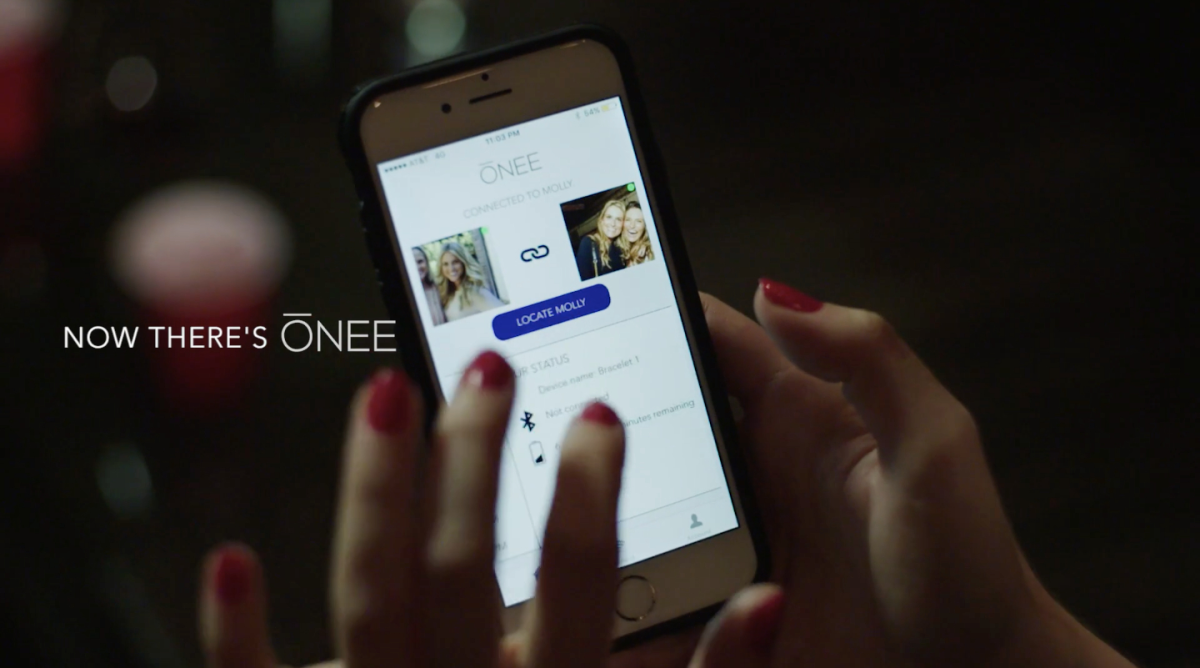This new piece of wearable tech, called the Ōnee, markets itself towards women who want to use “the buddy system” to keep track of one another while out on the town, at bars, clubs, crowded parties, and so on. As demonstrated in the corny commercial that I’ve embedded up top, two women both put on their matching Ōnee bracelets, sync the devices up to their respective smartphone apps, then go to a party together.
When one Ōnee owner needs to send a signal her fellow partier, she can give her bracelet a single tap on a button, and it’ll buzz her friend once. The two women can also send out an emergency alert–two taps, two buzzes. Within the smartphone app, there’s also a friend-finder functionality that’ll allow you to locate your Ōnee pal.
Obviously, this bracelet could be worn by anybody; I’m just saying women because it’s two women in the ad, and that’s clearly who it’s marketed towards. If the ad (and the rest of Onee’s marketing) is any indication, it looks like this bracelet is designed for well-to-do white ladies who go to rooftop parties. So, pretty narrow demographic there–but it makes sense given what the product does, which is: offer an expensive illusion of peace of mind.
First of all, the commercial paints a pretty unrealistic picture of how this bracelet would work–or rather, wouldn’t work–in real life. According to The Verge, the battery life is only six hours, so the Ōnee probably wouldn’t even make it through all of the late-night partying that happens in this ad. But that’s only the tip of the iceberg here.
My bigger problem is the entire ethos behind a product like this. Why focus so much design power on making devices marketed towards women that, essentially, put the onus upon them to protect themselves (and apparently, keep constant tabs on their female friends as well)? That’s already what society has been telling women to do since time immemorial: if anything happens to us, it’s supposedly our fault for not taking enough steps to “stay safe.” Never mind how expensive or unreasonable or downright impossible those steps might be. Never mind if those steps increase, rather than decrease, your sense of anxiety about navigating the world.
Ōnee is not even close to the only piece of tech with this concept that’s on the market today. The Riskband does the same thing as the Ōnee, as does the Nimb ring, and the Wiso bluetooth whistle.
Every single one of these product websites is clearly using identical marketing. Conventionally attractive women’s faces (usually thin, high-fashion, white women) are on the front page of every single one of those websites, alongside euphemisms that make it clear what the device should be used to prevent (mugging and stranger rape). “Make the world a safer place,” Nimb boasts. How would wearing a panic button do that, exactly? Does wearing the ring even help the wearer, really, let alone the world?
All of these pieces of tech follow the same pattern, which is that it’s a woman’s responsibility to take care of herself and her friends, because no one else will. In theory, this sounds empowering, and it’s wrapped up in messaging that wants to make you believe that it is. It’s implied to be somehow responsible and reasonable to expect women to own a product like this. But this product is actually just an expensive new way for you to text your friend.
These wearables do not “make the world a safer place.” They don’t combat or address or even acknowledge any systemic societal problems. They just do the same thing that society has always done, which is signal to marginalized people that it’s up to them to take care of themselves.
Wearable tech isn’t the only part of start-up culture that wants to “innovate” upon targeting women with more products that will supposedly help us “protect” ourselves. Remember this color-changing nail polish that was supposed to help women tell if their drink had gotten drugged? Same exact problem.
These products don’t even do much to help their owners evade the most statistically likely dangers, either. “Stranger rape” is incredibly rare compared to “acquaintance rape”, so marketing a roofie-detecting nail polish or a date-rape whistle won’t do much to help combat systemic problems. For all you know, the person most likely to betray your trust could be part of your emergency contact list (still not your fault if that should happen, by the way).
Anyway, I already (reluctantly) carry a GPS tracker with me everywhere: my phone. Most of the techniques in this commercial for Onee are stuff that I can do without buying a bracelet. I can text my friend or call their name across a room. I don’t think I need yet another reminder of the fact that no one, other than my friends, will care if anything bad happens to me. I’m already well aware of that fact.
Now if only we could find some way to “innovate” on teaching people about consent. Tech industry, how are you doing on that one?
(via The Verge, image via screencap)
Want more stories like this? Become a subscriber and support the site!
—The Mary Sue has a strict comment policy that forbids, but is not limited to, personal insults toward anyone, hate speech, and trolling.—
Follow The Mary Sue on Twitter, Facebook, Tumblr, Pinterest, & Google+.









Published: Sep 22, 2016 05:07 pm